Related Research Articles

John Constable was an English landscape painter in the Romantic tradition. Born in Suffolk, he is known principally for revolutionising the genre of landscape painting with his pictures of Dedham Vale, the area surrounding his home – now known as "Constable Country" – which he invested with an intensity of affection. "I should paint my own places best", he wrote to his friend John Fisher in 1821, "painting is but another word for feeling".
Seán Keating was an Irish romantic-realist painter who painted some iconic images of the Irish War of Independence and of the early industrialization of Ireland. He spent two weeks or so each year during the late summer on the Aran Islands and his many portraits of island people depicted them as rugged heroic figures. However, he ceased to visit the Aran Islands in 1965.
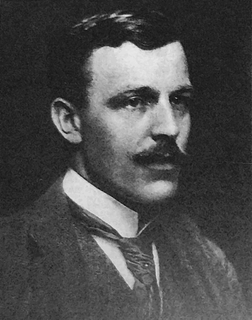
Sir James Guthrie was a Scottish painter, best known in his own lifetime for his portraiture, although today more generally regarded as a painter of Scottish Realism.

William James Glackens was an American realist painter and one of the founders of the Ashcan School, which rejected the formal boundaries of artistic beauty laid-down by the conservative National Academy of Design. He is also known for his work in helping Albert C. Barnes to acquire the European paintings that form the nucleus of the famed Barnes Foundation in Philadelphia. His dark-hued, vibrantly painted street scenes and depictions of daily life in pre-WW I New York and Paris first established his reputation as a major artist. His later work was brighter in tone and showed the strong influence of Renoir. During much of his career as a painter, Glackens also worked as an illustrator for newspapers and magazines in Philadelphia and New York City.

Albert Joseph Moore was an English painter, known for his depictions of languorous female figures set against the luxury and decadence of the classical world.
Frank Graham Bell was a painter of portraits, landscapes and still-life, and a founder member of the realist Euston Road School. He was also a journalist and writer on art and the artist. Born in South Africa, he spent most of his career in Britain (1931–1943), where he died in a flying accident during World War II.

John Arthur Malcolm Aldridge was a British oil painter, draftsman, wallpaper designer, and art teacher in the United Kingdom. He was elected an Associate of the Royal Academy (ARA) in 1954 and a Royal Academician (RA) in 1963.
Professor Maurice Cockrill, was a British painter and poet.

George Wallis (1811–1891) was an artist, museum curator and art educator. He was the first Keeper of Fine Art Collection at South Kensington Museum in London.

James Coutts Michie ARSA was a Scottish painter who specialised in landscapes and portraits.

Zsuzsi Roboz was a London-based Hungarian painter known for her portraiture paintings and paintings of the arts. Her work is in public galleries including the Tate Britain and The National Portrait Gallery.
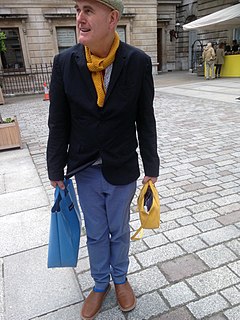
Humphrey Ocean is a contemporary British painter.
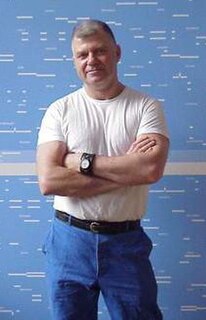
Keith Milow is a British artist. He grew up in Baldock, Hertfordshire, and lived in New York City (1980–2002) and Amsterdam (2002–2014), now lives in London. He is an abstract sculptor, painter and printmaker. His work has been characterised as architectural, monumental, procedural, enigmatic and poetical.

John Nelson Shanks was an American artist and painter. His best known works include his portrait of Diana, Princess of Wales, first shown at Hirschl & Adler Gallery in New York City, April 24 to June 28, 1996 and the portrait of president Bill Clinton for the National Portrait Gallery.
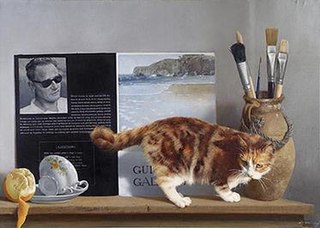
Patrick Anthony Hennessy RHA was an Irish realist painter. He was known for his highly finished still lifes, landscapes and trompe l'oeil paintings. The hallmark of his style was his carefully observed realism and his highly finished surfaces, the result of a virtuoso painting technique. He was brought up in Arbroath by his mother and step-father, his father having been killed during World War One. He attended Dundee School of Art where he met his lifelong companion, the painter Henry (Harry) Robertson Craig. Two of his paintings were accepted in 1939 at the Royal Scottish Academy for their Annual Exhibition. For the next 29 years he lived in Ireland with extended trips abroad. He was elected a member of the Royal Hibernian Academy in 1949. The Hendriks Gallery in Dublin and the Guildhall Galleries in Chicago were the main outlets for his work. In the late 1960s he moved permanently to Tangier and then, after suffering ill health, to the Algarve. He died in London.
Harold Jacob Bruder is an American realist painter. In 1984, he was honored with a National Endowment for the Arts Fellowship. He is a former professor of art, working with the Kansas City Art Institute, Pratt Institute, National Academy of Design, Aspen Art Museum, and Queens College of the City University of New York (CUNY). He served as the Chairman of the Art Department at CUNY, where he taught painting and drawing for 30 years, retiring in 1995, as Professor Emeritus.

Carl Randall is a British figurative painter, whose work is based on images of modern Japan and London.

Mark Burrell is a British Artist, born and resident in Lowestoft, Suffolk, UK. He spent a year during his childhood in Libya. Returning to Lowestoft he studied art at Lowestoft College but considers himself self-taught.

Nahem Shoa is a contemporary London painter best known for his series of portraits, collectively called Giant Heads, which were painted at up to 15 times life size. He is also notable for having increased the number of portraits of Black and mixed-race British people on display in British museums. Shoa has won a number of awards and prizes for his work, and serves on The Royal Albert Memorial Museum and Art Gallery's Contemporary Arts Panel. His work has been exhibited in London's National Portrait Gallery and the Royal Academy as well as at galleries and museums in other parts of the UK.
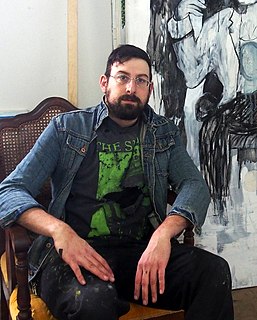
Abshalom Jac Lahav is a New York City–based artist. He is known for his series 48 Jews and The Great Americans which have been shown at museums such as Richmond Art Museum, Samuel Dorsky Museum of Art, The Oregon Jewish Museum and Jewish Museum of Florida. His painting style implements well known images of famous people in the modern contexts, but still references historical modes of painting and black-and-white photography through its use of monotone imagery. He is also the founder of the Midnight Society, an artist run curatorial project based in Brooklyn, New York.
References
- ↑ "The Artist I Grew Up With John Parks". The New York Review of Books. Retrieved 20 November 2012.
- ↑ "John Alexander Parks". Artsy. Retrieved 21 March 2016.
- ↑ "There's Always One In the Crowd". Print Magazine. Retrieved 8 April 2015.
- ↑ Smith, Roberta (13 December 2012). "John A. Parks: 'Paint and Memory'". The New York Times. ISSN 0362-4331 . Retrieved 3 November 2021.
- ↑ Victoria and Albert Museum. "Catalogue". Victoria and Albert Museum. Retrieved 15 January 2017.
- ↑ "1316 Camden Town". Rhode Island School of Design. Retrieved 23 September 2011.
- ↑ "John Alexander Parks Birth". FreeBMD. Retrieved 13 January 2017.
- ↑ "John Alexander Parks – 532 Gallery Thomas Jaeckel". 532 Gallery Thomas Jaeckel. Retrieved 12 March 2015.
- ↑ "John Parks". School of Visual Arts. Retrieved 12 March 2015.
- ↑ "Universal Principles of Art by John Alexander Parks". Amazon. Retrieved 2 December 2014.
- ↑ "A Conversion with Artist John A. Parks". Stay Thirsty Magazine. Retrieved 8 April 2015.
- ↑ "Universal Principles of Art". Quarto Knows. Retrieved 8 January 2017.
- ↑ "The Progress of Love (2011)". IMDb. Retrieved 12 March 2011.